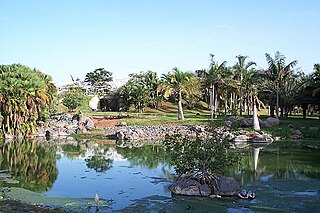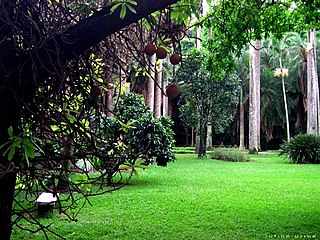
Sir Seewoosagur Ramgoolam was a Mauritian physician, politician, and statesman. He served as the island's only chief minister, first prime minister, and fifth governor-general.

Pamplemousses is a district of Mauritius, located in the north west of the island, and is one of the most densely populated parts of the island. The name of the district comes from the French word for grapefruits. The district has an area of 178.7 km2 and the population estimate was at 139,966 as of 31 December 2015.

Pierre Poivre was an 18th-century horticulturist and botanist. He was born in Lyon, France.

Hyophorbe amaricaulis is a species of palm tree of the order Arecales, family Arecaceae, subfamily Arecoideae, tribe Chamaedoreeae. It is found exclusively on the island of Mauritius, and only a single surviving specimen has been documented in the Curepipe Botanic Gardens in Curepipe. Thus, it is classified as an endling.

The Palmetum of Santa Cruz de Tenerife is a botanical garden of 120.000 m² specialized in palms (Arecaceae). It is an artificial hill, with views of the ocean, located in Santa Cruz de Tenerife, Canary Islands, Spain. The gardens include a large system of waterfalls, streams and ponds, a museum dedicated to palms, and a display shade house. The project was started in 1995 on a former landfill and only opened to the public in 2014. The valuable palm collection gathers about 600 species of palms and it is focused on the ones native to world islands. Trees and shrubs of other plant families are also displayed, organised in "biogeographical sections". All gardens are maintained with no pesticides and no fertilizers, different species of wild birds are easily seen in the palmetum.

The Sir Seewoosagur Ramgoolam Botanic Garden, commonly known as the Pamplemousses Botanic Garden, is a popular tourist attraction in Pamplemousses, near Port Louis, Mauritius, and the oldest botanical garden in the Southern Hemisphere. Famous for its long pond of giant water lilies, the garden was first constructed by Pierre Poivre in 1770, and it covers an area of around 37 hectares.

The San Juan Botanical Garden, officially known as the Botanical Garden of the University of Puerto Rico, is located in the Caribbean city of San Juan, capital of Puerto Rico. This lush 300-acre (1.2 km2) “urban garden” of native and exotic flora serves as a laboratory for the study, conservation and enrichment of plants, trees, flowers, grasses and many other plants. Seventy-five acres are landscaped and open to the general public as well as researchers.

Hyophorbe is a genus of five known species of flowering plants in the family Arecaceae, native to the Mascarene Islands in the Indian Ocean. All five species can attain heights of over 6 meters, and two of the species develop swollen trunks that have made them popular as ornamentals, but all of them are endangered in the wild.

Hyophorbe vaughanii is a species of flowering plant in the family Arecaceae that is endemic to Mauritius. Its natural habitat is subtropical or tropical dry forests.

Hyophorbe verschaffeltii, the palmiste marron or spindle palm, is a critically endangered species of flowering plant in the family Arecaceae. It is endemic to Rodrigues island, Mauritius, but is widely grown in cultivation.

An endling is the last known individual of a species or subspecies. Once the endling dies, the species becomes extinct. The word was coined in correspondence in the scientific journal Nature. Alternative names put forth for the last individual of its kind include ender and terminarch.

The Jardin botanique exotique de Menton, also known as the Jardin botanique exotique du Val Rahmeh, is a botanical garden located off Avenue St Jacques, Menton, Alpes-Maritimes, Provence-Alpes-Côte d'Azur, France. It is open daily except Tuesday; an admission fee is charged.

The Jardin des plantes de Nantes is a municipal botanical garden located on Rue Stanislas Baudry, Nantes, Loire-Atlantique, Pays de la Loire, France. It is open daily without charge, but a fee is charged for the greenhouses.

The Conservatoire botanique national de Mascarin is a national conservatory and botanical garden located at 2, rue du Père Georges, Colimaçons, Saint-Leu, Réunion, France. It is open daily except Monday; an admission fee is charged.

The Flora und Botanischer Garten Köln is a municipal formal park and botanical garden located adjacent to Cologne Zoological Garden at Amsterdamer Straße 34, Cologne, North Rhine-Westphalia, Germany. It is open daily without charge.

Jean-Nicolas Céré was a French botanist and agronomist born on the Indian Ocean Isle de France but educated in Brittany and Paris. On the Isle de France he was befriended by Pierre Poivre (1719–1786), administrator of the Isle de France and Ile Bourbon (Réunion), who he assisted in the cultivation of spices. When Poivre was recalled to France in 1773 Céré was appointed Director of the Royal Garden at Monplaisir, a position he held from 1775 to the time of his death in 1810.

The Caracas Botanical Garden, also known as Central University of Venezuela Botanical Garden, is part of the University City of Caracas World Heritage Site.

The Jardín Botánico Histórico La Concepción is an English landscape garden with over one hundred and fifty years of history. It is located at the northern entrance of the Spanish city of Málaga. This garden is one of the few gardens with subtropical plants that exist in Europe. It has more than fifty thousand plants, of two thousand species of tropical, subtropical, and autochthonous, highlighting the collection with more than one hundred different species of palms, bamboos, aquatic plants and its historical garden.




















